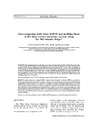Identificador persistente para citar o vincular este elemento:
https://accedacris.ulpgc.es/jspui/handle/10553/881
| Título: | Intercomparing drifts from RAFOS and profiling floats in the deep western boundary current along the Mid-Atlantic Ridge | Otros títulos: | Comparación de flotadores RAFOS y derivadores-perfiladores autónomos APEX en la corriente profunda de frontera oeste de la dorsal centroatlántica | Autores/as: | Send, Uwe Zenk, Walter Machín, Francisco |
Clasificación UNESCO: | 251007 Oceanografía física | Palabras clave: | Lagrange Corriente profunda de Frontera Oeste Dorsal centroatlántica Apex Cycling Float, et al. |
Fecha de publicación: | 2006 | Publicación seriada: | Scientia Marina | Resumen: | The Lagrangian nature of cycling floats is evaluated in the framework defined by the Deep Western Boundary Current of the Mid-Atlantic Ridge. In a statistical approach, speeds and drifts are estimated for an APEX cycling float and compared with the velocities inferred from a park ensemble of four eddy-resolving RAFOS floats. They were deployed at the same location and ballasted for drifting at the same mission depth. Displacement errors induced by geostrophic shear and wind forced currents are analyzed. We observe that the velocity estimated from the RAFOS floats is not statistically different from the velocity estimated from the APEX float. Likewise, the initial separation between the cycling float and a simultaneously deployed RAFOS float has been studied in terms of the turbulent diffusivity. Though the performance of this study in comparable cases without a mean current field may be limited, these oceanic observations support exploiting the Lagrangian nature of the cycling floats. En este trabajo se examina la naturaleza lagrangiana de los derivadores-perfiladores autónomos en el contexto definido por la Corriente Profunda de Frontera Oeste de la Dorsal Centroatlántica. Desde un punto de vista estadístico, se comparan la velocidad y trayectoria subsuperficiales de una boya APEX con las estimadas a partir de un conjunto de cuatro boyas subsuperficiales RAFOS. Todas fueron lanzadas en la misma posición y lastradas para derivar a la misma profundidad. Asimismo, se ha analizado el error inducido por el cizallamiento vertical de la velocidad debida tanto a la geostrofía como a Ekman. En este sentido, hemos comprobado que la velocidad estimada por medio de los derivadores RAFOS no es estadísticamente diferente de la estimada por el perfilador APEX. Por otro lado, la separación inicial de las boyas se ha estudiado en términos de la difusividad turbulenta del medio. Finalmente, podemos afirmar que estas observaciones apoyan el aprovechamiento de la naturaleza lagrangiana de los derivadores-perfiladores. |
URI: | https://accedacris.ulpgc.es/handle/10553/881 | ISBN: | 2148358 | ISSN: | 0214-8358 | DOI: | 10.3989/scimar.2006.70n11 | Fuente: | Scientia Marina [ISSN 0214-8358], v. 70 (1), p. 1-8, (Enero 2006) |
| Colección: | Artículos |
Citas SCOPUSTM
10
actualizado el 08-jun-2025
Citas de WEB OF SCIENCETM
Citations
9
actualizado el 08-jun-2025
Visitas
139
actualizado el 01-nov-2024
Descargas
125
actualizado el 01-nov-2024
Google ScholarTM
Verifica
Altmetric
Comparte
Exporta metadatos
Los elementos en ULPGC accedaCRIS están protegidos por derechos de autor con todos los derechos reservados, a menos que se indique lo contrario.
